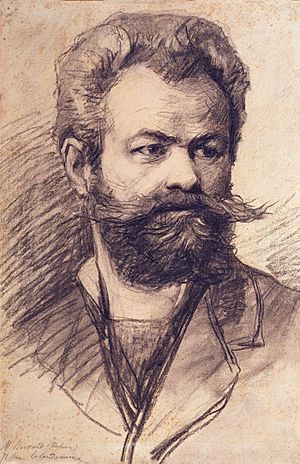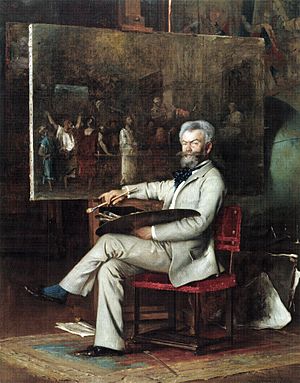Mihály Munkácsy facts for kids
Quick facts for kids
Mihály Munkácsy
|
|
|---|---|

Self-portrait drawing (1870s)
|
|
| Born |
Mihály Leó Lieb
20 February 1844 Munkács, Kingdom of Hungary (now Mukachevo, Ukraine)
|
| Died | 1 May 1900 Endenlich, German Empire
|
| Nationality | Hungarian |
| Known for | Painter |
| Movement | Realism, Düsseldorf school of painting |
| Spouse(s) | Cecile Papier |
| Awards | Gold Medal (Paris Salon 1870) |
Mihály Munkácsy was a famous Hungarian painter. He was born on February 20, 1844, and passed away on May 1, 1900. He became well-known around the world for his paintings of everyday life and his large religious artworks.
Contents
Becoming an Artist
Mihály Munkácsy was born Mihály Leó Lieb in Munkács, Hungary. He later took the name Munkácsy from his hometown. When he was young, he learned painting from Elek Szamossy, a traveling artist.
Munkácsy then moved to Pest, a big city in Hungary. There, he looked for help from other artists. With support, he received a special grant to study art abroad. In 1865, he studied in Vienna, and in 1866, he went to the Munich Academy.
In 1868, he moved to Düsseldorf to study with Ludwig Knaus, a popular painter. He also visited Paris in 1867 to see a big art show called the Universal Exposition. After this trip, his painting style changed. It became lighter, with bigger brushstrokes and softer colors. This was likely because of the modern French art he saw.
Early in his career, Munkácsy mostly painted scenes of peasants and poor people. He used bright colors and a dramatic style, like in his paintings The Cauldron (1864) and Easter Merrymaking (1865). Later, he started to include more of the landscape around his figures, as seen in Storm in the Puszta (1867). He learned to show different feelings in his characters and paint them in groups. This style is part of the Düsseldorf school of painting.
The Last Day of a Condemned Man
In 1869, Munkácsy painted a very famous work called The Last Day of a Condemned Man. Many people consider this his first masterpiece. This painting won a Gold Medal at the Paris Salon in 1870. It made Munkácsy an instantly popular artist. The painting shows the feelings of people facing a sad and difficult end. It truly showed how skilled Munkácsy was as a painter.
After this success, Munkácsy moved to Paris with his friend, László Paál. He lived there for the rest of his life. He continued to paint scenes of everyday life, like Making Lint (1871). The best years of his career were from 1873 to 1875. During this time, he painted works like Midnight Ramblers and Pawnshop. In 1874, he married Cecile Papier. After his marriage, his style changed again. He started painting colorful salon scenes and still lifes, moving away from his earlier realistic subjects.
In the late 1870s, he also painted landscapes in Barbizon, France. These paintings, like Dusty Road and Walking in the Woods, were fresh and full of color. He also painted realistic portraits of famous people, including the composer Franz Liszt.
In 1878, Munkácsy painted a historical scene called The Blind Milton Dictating Paradise Lost to his Daughters. This painting was a new step in his career. It shows a richly decorated room. An art dealer named Charles Sedelmeyer bought this painting. Sedelmeyer then offered Munkácsy a ten-year contract. This deal made Munkácsy very rich and a well-known artist in Paris.
The Christ Trilogy
Charles Sedelmeyer wanted Munkácsy to paint very large pictures that could be shown on their own. They decided that scenes from the Bible would be perfect. In 1882, Munkácsy painted Christ in front of Pilate. This was followed by Golgotha in 1884. The third painting, Ecce Homo, completed the series in 1896.
Sedelmeyer took these three huge paintings on tours across Europe and the United States. The first two were bought by John Wanamaker, a department store owner in the US. After Wanamaker's death, these paintings were shown in his Philadelphia store every Easter. People would often enjoy special music programs with the art. The large size of the store's Grand Court was perfect for these huge paintings.
For many years, the Hungarian government wanted to own these paintings. In 2002, Christ in front of Pilate was given to the Art Gallery of Hamilton in Canada. It was loaned to the Déri Museum in Debrecen, Hungary, several times. In 2009, all three paintings were displayed together in a special part of the Déri Museum. In 2014, the Hungarian government bought Christ in front of Pilate for $5.7 million.
Munkácsy also continued to paint everyday scenes. In the 1880s, he painted many salon pictures. These showed the fancy homes of wealthy people. He often painted themes like motherhood, happy family moments, children, and animals. His elegant young women also appeared in outdoor settings. These paintings were very popular, especially with buyers in the United States, and sold for high prices. Besides these city scenes, Munkácsy also painted rural landscapes that were dramatic and full of emotion.
Later Works and Legacy
Towards the end of his career, Munkácsy painted two very large works. One was Hungarian Conquest for the House of Parliament in Hungary. The other was a ceiling painting called Apotheosis of Renaissance for the Kunsthistorisches Museum in Vienna.

The Vienna ceiling painting, finished in 1888, was titled Glorification of the Renaissance. Munkácsy became very famous and enjoyed a comfortable life. However, he often doubted his own artistic talent. His last paintings sometimes seemed troubled or unusual. For example, Victim of Flowers (1896) was one of his later works.
As his health declined, he completed two more paintings with several figures. One of these, Strike (1896), showed a topic that was unusual for his time. It had a new way of showing characters, but still kept some of his old passionate style.
Final Years
In the summer of 1896, Munkácsy's health became much worse. After getting treatment, he moved to Colpach and Paris. Later, he was taken to a mental hospital in Endenich, near Bonn. He passed away there on May 1, 1900. On May 9, he was buried in the Kerepesi Cemetery in Budapest.
Munkácsy's art is very important to understanding 19th-century painting and Hungarian art history. His works are seen as the peak of national painting in Hungary. He set a high standard for other artists. He was one of the few artists who brought the older painting techniques of the Austro-Hungarian Empire to their most powerful and rich expression.
In 2005, the Hungarian National Gallery held a big exhibition of Munkácsy's paintings. It was the first time so many of his works, from all over the world, were shown together. About 120 paintings were borrowed from museums and private collections. The exhibition was a great chance for Hungarians to see his original works. Munkácsy's paintings can be found in many museums today, including the Milwaukee Art Museum and the Frye Art Museum in Seattle.
- Hungary has honored Mihály Munkácsy with postage stamps. One stamp from 1932 shows his portrait. Another from 1977 shows his painting Flowers.
- Luxembourg also honored him with two postage stamps in 1996.
- A crater on the planet Mercury is named after him.
See also
 In Spanish: Mihály Munkácsy para niños
In Spanish: Mihály Munkácsy para niños







